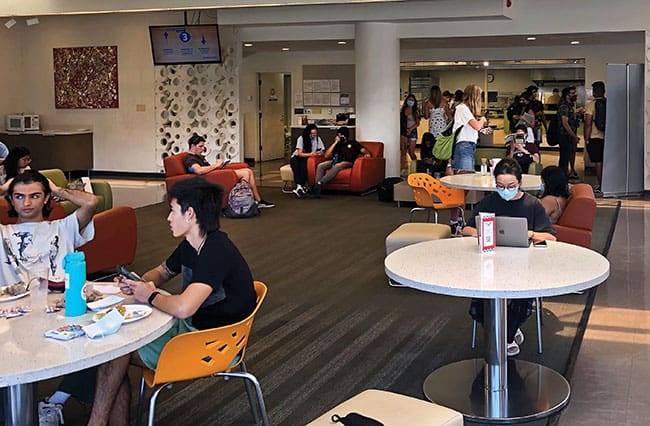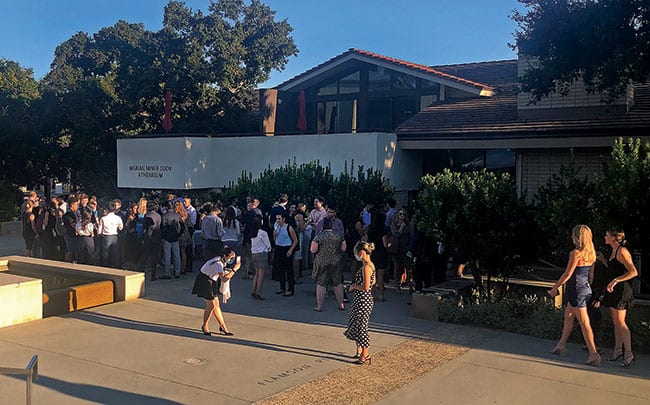A day in the life of a Claremont college student

by Gabriel Fisher
It’s 11:40 a.m. I sit on the concrete ground to the side of the outdoor COVID-19 testing stations, waiting to observe students passing through.
Two people have approached since I started writing a minute ago. Already, both students sneeze repeatedly when they insert testing swabs up their nostrils.
Once they transfer their swabs to their sterile testing tubes, they walk from the testing stations to inside McKenna Auditorium, where, after a few more quick procedures, they drop their tests into a large bin. One to two days later, they will learn of their COVID status via email or text. As of September 10, a total of 99.9% have received a favorable outcome.
I have now been observing the testing station for a few minutes. No more sneezes, just coughs and rapidly blinking eyes, and also laughs because of the tickling sensation, but likely also because of the weirdness of this routine. Two years ago, nobody could have predicted this reality—the entire school sticking swabs up their noses to scan for a novel virus. It is clear why people chuckle.
Wait, more sneezes. At this point, twenty minutes after I sit down, I guess the sneeze rate to be 30%. The sneeze and/or cough rate, 50%. The “I-am-uncomfortable rate,” near 100%.
I ask a junior what it’s like to take the test. “Uncomfortable, but worth it,” he says. He seems happy to be on campus for what is only his second full semester in person.
His sentiment aligns with what I hear from the testing supervisor of Hamilton Health Box.
“No pushback, no frustration,” he says.
As it should be.
After sitting hunched over on the concrete ground for an hour, I make the one-minute walk to the Hub, a popular area where students congregate to eat, work and socialize. I sit at one of the 16 outdoor tables, mine facing the campus’s main walkway, my field of view exposed to only 40 or so yards of its much longer length. I look out at an iconic feature, the fountains, a five-part arrangement with a square-shaped pool in the center and two fountains flanking it, which themselves are flanked by two additional pools.
I watch a fellow fifth-year senior walk by. He wears a stylish all-black outfit, his jeans ending just above his ankle, showing the entire shoe. He holds a to-go box of food in one hand (they’re popular these days with all of the added outdoor seating) and a drink in the other.
Many things haven’t changed since the pandemic, one being the means of transportation that students use to move about campus. The most common is the skateboard, some use scooters. I smile when I see two cute cruiser bikes pass by. They remind me of my time cycling around Amsterdam during my COVID-shortened study abroad experience.
I walk inside the Hub. Some students lounge alone in deep chairs with headphones over their ears. People socializing sit at the booths completing work, often on their computers. Others eat the typical Hub offerings: mozzarella sticks, cheeseburgers, chicken tenders, pre-made salads. I choose my personal favorite, the cheese quesadilla.
I then walk outside to head to class.
One hand gripping the left handlebar, the other holding a paper plate supporting my last slice of quesadilla, I peddle two minutes from the Hub to the Bauer Center Forum to observe professor Fernholz’s intro-level principles of economics course, better known as ECON 50 around campus.
Observing this course brings about a bit of anxiety. I struggled during it my first semester of college, resulting in the lowest grade of my academic career.
Before delving into today’s lesson on supply and demand, professor Fernholz explains the logistics of the upcoming quiz. The format is open note — he’s carrying it over from our time learning remotely, which he says worked well. To compensate for this new advantage, the questions will be more challenging. We also learn that a student is present via Zoom. He says a virtual hello to the class, some students chuckle in response.
For the lesson, professor Fernholz talks about supply and demand and elasticity. Students interact with each other via a game on MobLab, an EdTech software app. Students “sell” and “buy” oranges –– sellers try to get as much money as possible, while buyers hope to pay as little as possible. I think this game intends to mimic market forces. I might have known if I was better versed in economics.
Per usual during large lectures, some students veer off task. One student looks at Snapchat and Instagram then later reads a news article; one checks her text messages; another plays online chess. To their credit, they are only temporarily distracted … all return to participate when it’s time to play in MobLab.
I approach professor Fernholz after the lecture and ask if he feels class has returned to the holy grail of complete normality. He says we’re trending in the right direction.
“It’s not 100% normal,” he says, but it’s “better than last semester.” He adds that students are more engaged and he’s happier.
I depart the lecture hall for the faculty offices where I briefly interview professor Taw, an international relations scholar who taught me foreign relations of the United States two years ago.
I ask her how teaching changed during Zoom classes. She says it obscured her ability to read people’s faces and reactions to class discussion.
“The energy you get from being in the classroom together just couldn’t be replaced on Zoom,” she says. “You can feel (an idea) palpably in the room when people resonate with the idea … and on Zoom you just don’t get that resonance.”
I leave professor Taw’s office for my apartment located on the outskirts of campus and briefly decompress after running around for the past few hours. My rest is short.
I cycle back to the Hub to observe students attending the Athenaeum, known as the “Ath”. I overlook a crowd of formally dressed students eating hors d’oeuvres and drinking, students 21 and older can choose wine. When the students sit down to eat a moderately gourmet meal at a tablecloth-covered outdoor table, I eat dining hall food next to a friend.
The Ath is a program put on four nights weekly where students eat a formal dinner before listening to the evening’s speaker. Speakers are experts in their fields and over the years have included Bill Clinton and Anderson Cooper.
Soon after I finish my dinner across the path from the Ath-goers, I join them in the auditorium to watch Katy Milkman, a professor visiting from The Wharton School of the University of Pennsylvania. She delivers a talk on how to change behaviors. During normal times, dinner takes place indoors. But now, without the need for indoor tables, chairs completely fill the auditorium.
Milkman delivers her talk. It’s nothing too inspiring. I then return to my apartment, away from the main part of campus, where I begin to wind down my day.










0 Comments